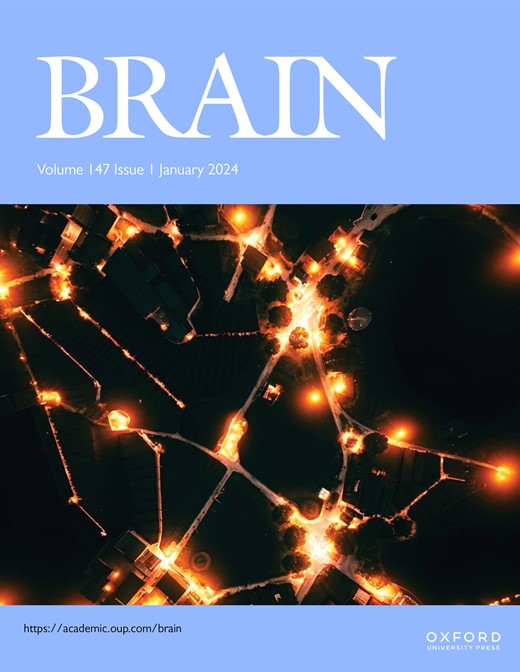认知和神经精神特征区分非典型帕金森综合征
IF 10.6
1区 医学
Q1 CLINICAL NEUROLOGY
引用次数: 0
摘要
非典型帕金森综合征与帕金森病的区别在于附加的神经学体征和特征性的潜在神经病理学。然而,它们在诊断上具有挑战性,进展迅速,并且通常在病程晚期才被诊断出来。他们不同的人口学特征和预后得到了很好的研究,但伴随的认知和精神特征也可能有助于诊断。进行性核上性麻痹(PSP)和皮质基底综合征(CBS)可能导致与额颞叶痴呆重叠的认知和行为表现,包括非流利性失语、冷漠和冲动。临床诊断标准的敏感性有限,病理证实的PSP通常表现为初始临床综合征,而不是PSP-理查森综合征。在这里,我们整合了来自PROSPECT和Oxford Discovery队列的横断面多中心基线数据。这使我们能够比较1138名PSP、CBS、多系统萎缩(MSA)和特发性帕金森病(PD)患者的认知和精神特征。使用多元线性回归对来自不同队列的数据进行协调和比较。有五个关键结果。1. 使用现成的“床边”筛查工具,不同的综合征表现出不同的认知特征。与PD相比,PSP的额叶执行功能障碍最为明显,CBS的视觉空间缺陷,MSA的记忆和执行功能缺陷较轻。2. 最常见的神经精神特征是CBS患者的抑郁和焦虑,PSP患者的冷漠,PD患者常见的睡眠障碍。正如预期的那样,在所有疾病中,冷漠与冲动呈正相关。神经精神特征通常比认知领域更能区分非典型帕金森综合征。3. 认知功能和运动严重程度随病程的延长而下降,运动功能预测PSP、CBS和PD的认知,而MSA不预测,表明MSA的认知和运动功能障碍是分离的。4. 血浆神经丝轻链(NFL)水平,在一部分患者中测量,与PSP的认知缺陷相关,但与运动缺陷无关。5. 在控制了运动严重程度后,认知缺陷导致了日常生活活动的损害,MoCA每两分,施瓦布和英格兰的得分就会下降一分。在未来的神经保护疗法的预期,我们提出了一个分类器,以提高体内非典型帕金森综合征的诊断准确性。具有神经病理学金标准诊断资源的纵向队列研究对于验证更好的PSP、CBD、MSA和非典型帕金森病患者的诊断工具仍然很重要。本文章由计算机程序翻译,如有差异,请以英文原文为准。
Cognitive and neuropsychiatric profiles distinguish atypical parkinsonian syndromes
Atypical parkinsonian syndromes are distinguished from Parkinson’s disease by additional neurological signs and characteristic underlying neuropathology. However, they can be diagnostically challenging, rapidly progressive, and are often diagnosed late in disease course. Their different demographic features and prognoses are well studied, but the accompanying cognitive and psychiatric features may also facilitate diagnosis. Progressive supranuclear palsy (PSP) and corticobasal syndrome (CBS) may cause cognitive and behavioural manifestations that overlap with frontotemporal dementia, including non-fluent aphasia, apathy and impulsivity. Clinical diagnostic criteria have limited sensitivity, with pathologically confirmed PSP often having presented an initial clinical syndrome other than PSP-Richardson’s syndrome. Here we integrate cross-sectional multi-centre baseline data from the PROSPECT and Oxford Discovery cohorts. This allowed us to compare cognitive and psychiatric features across a total of 1138 people with PSP, CBS, multiple-system atrophy (MSA), and idiopathic Parkinson’s disease (PD). Data from the different cohorts were harmonised and compared using multiple linear regression. There were five key results. 1. Different syndromes showed distinctive cognitive profiles, using readily applicable ‘bedside’ screening tools. Frontal executive dysfunction was most evident in PSP, visuospatial deficits in CBS, with milder deficits in memory and executive function in MSA, as compared with PD. 2. The most prevalent neuropsychiatric features were depression and anxiety in CBS, apathy in PSP, with sleep disturbances common in PD. As expected, apathy correlated positively with impulsivity across all disorders. Neuropsychiatric features were generally better at discriminating between atypical parkinsonian syndromes than were the cognitive domains. 3. Both cognitive function and motor severity declined with disease duration, and motor function predicted cognition in PSP, CBS and PD but not in MSA, suggesting that in MSA cognitive and motor dysfunction are decoupled. 4. Plasma neurofilament light chain (NFL) levels, measured in a subset of patients, correlated with cognitive deficits in PSP, but not motor deficits. 5. Cognitive deficits contributed to the impairment in activities of daily living after controlling for motor severity, with every two points on the MoCA worsening the Schwab and England score by one point. In anticipation of future neuroprotective therapies, we present a classifier to improve diagnostic accuracy for atypical parkinsonian syndromes in vivo. Longitudinal cohort studies with resources for neuropathological gold-standard diagnosis remain important to validate better diagnostic tools for people with PSP, CBD, MSA and atypical parkinsonism.
求助全文
通过发布文献求助,成功后即可免费获取论文全文。
去求助
来源期刊

Brain
医学-临床神经学
CiteScore
20.30
自引率
4.10%
发文量
458
审稿时长
3-6 weeks
期刊介绍:
Brain, a journal focused on clinical neurology and translational neuroscience, has been publishing landmark papers since 1878. The journal aims to expand its scope by including studies that shed light on disease mechanisms and conducting innovative clinical trials for brain disorders. With a wide range of topics covered, the Editorial Board represents the international readership and diverse coverage of the journal. Accepted articles are promptly posted online, typically within a few weeks of acceptance. As of 2022, Brain holds an impressive impact factor of 14.5, according to the Journal Citation Reports.
 求助内容:
求助内容: 应助结果提醒方式:
应助结果提醒方式:


